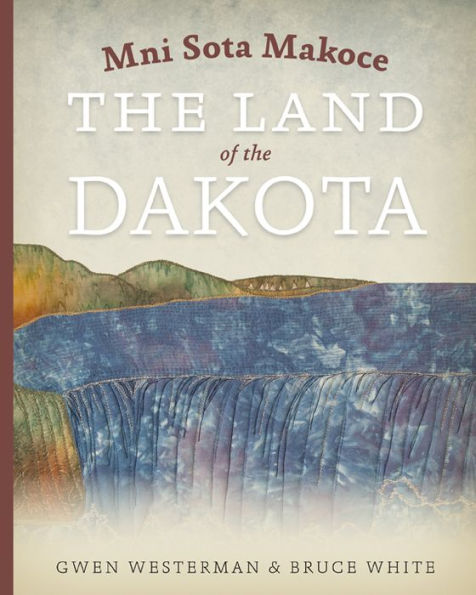Mni Sota Makoce: The Land of the Dakota
Much of the focus on the Dakota people in Minnesota rests on the tragic events of the 1862 U.S.-Dakota War and the resulting exile that sent the majority of the Dakota to prisons and reservations beyond the state’s boundaries. But the true depth of the devastation of removal cannot be understood without a closer examination of the history of the Dakota people and their deep cultural connection to the land that is Minnesota. Drawing on oral history interviews, archival work, and painstaking comparisons of Dakota, French, and English sources, Mni Sota Makoce tells the detailed history of the Dakota people in their traditional homelands for at least hundreds of years prior to exile.
“Minnesota” is derived from the Dakota phrase Mni Sota Makoce, Land Where the Waters Reflect the Clouds—and the people’s roots here remain strong. Authors Gwen Westerman and Bruce White examine narratives of the people’s origins, their associations with the land, and the seasonal round though key players and place names. They consider Dakota interactions with Europeans and offer an in-depth “reading between the lines” of historical documents—some of them virtually unknown—and treaties made with the United States, uncovering misunderstandings and outright deceptions that helped lead to war in 1862.
Dakota history did not begin with the U.S.-Dakota War of 1862—nor did it end there. Mni Sota Makoce is, more than anything, a celebration of the Dakota people through their undisputed connection to this place, Minnesota, in the past, present, and future.
Gwen Westerman is professor of E nglish and Humanities at Minnesota State University, Mankato. Bruce White is author of We Are at Home: Pictures of the Ojibwe People.
1110871233
“Minnesota” is derived from the Dakota phrase Mni Sota Makoce, Land Where the Waters Reflect the Clouds—and the people’s roots here remain strong. Authors Gwen Westerman and Bruce White examine narratives of the people’s origins, their associations with the land, and the seasonal round though key players and place names. They consider Dakota interactions with Europeans and offer an in-depth “reading between the lines” of historical documents—some of them virtually unknown—and treaties made with the United States, uncovering misunderstandings and outright deceptions that helped lead to war in 1862.
Dakota history did not begin with the U.S.-Dakota War of 1862—nor did it end there. Mni Sota Makoce is, more than anything, a celebration of the Dakota people through their undisputed connection to this place, Minnesota, in the past, present, and future.
Gwen Westerman is professor of E nglish and Humanities at Minnesota State University, Mankato. Bruce White is author of We Are at Home: Pictures of the Ojibwe People.
Mni Sota Makoce: The Land of the Dakota
Much of the focus on the Dakota people in Minnesota rests on the tragic events of the 1862 U.S.-Dakota War and the resulting exile that sent the majority of the Dakota to prisons and reservations beyond the state’s boundaries. But the true depth of the devastation of removal cannot be understood without a closer examination of the history of the Dakota people and their deep cultural connection to the land that is Minnesota. Drawing on oral history interviews, archival work, and painstaking comparisons of Dakota, French, and English sources, Mni Sota Makoce tells the detailed history of the Dakota people in their traditional homelands for at least hundreds of years prior to exile.
“Minnesota” is derived from the Dakota phrase Mni Sota Makoce, Land Where the Waters Reflect the Clouds—and the people’s roots here remain strong. Authors Gwen Westerman and Bruce White examine narratives of the people’s origins, their associations with the land, and the seasonal round though key players and place names. They consider Dakota interactions with Europeans and offer an in-depth “reading between the lines” of historical documents—some of them virtually unknown—and treaties made with the United States, uncovering misunderstandings and outright deceptions that helped lead to war in 1862.
Dakota history did not begin with the U.S.-Dakota War of 1862—nor did it end there. Mni Sota Makoce is, more than anything, a celebration of the Dakota people through their undisputed connection to this place, Minnesota, in the past, present, and future.
Gwen Westerman is professor of E nglish and Humanities at Minnesota State University, Mankato. Bruce White is author of We Are at Home: Pictures of the Ojibwe People.
“Minnesota” is derived from the Dakota phrase Mni Sota Makoce, Land Where the Waters Reflect the Clouds—and the people’s roots here remain strong. Authors Gwen Westerman and Bruce White examine narratives of the people’s origins, their associations with the land, and the seasonal round though key players and place names. They consider Dakota interactions with Europeans and offer an in-depth “reading between the lines” of historical documents—some of them virtually unknown—and treaties made with the United States, uncovering misunderstandings and outright deceptions that helped lead to war in 1862.
Dakota history did not begin with the U.S.-Dakota War of 1862—nor did it end there. Mni Sota Makoce is, more than anything, a celebration of the Dakota people through their undisputed connection to this place, Minnesota, in the past, present, and future.
Gwen Westerman is professor of E nglish and Humanities at Minnesota State University, Mankato. Bruce White is author of We Are at Home: Pictures of the Ojibwe People.
25.95
In Stock
5
1

Mni Sota Makoce: The Land of the Dakota
296
Mni Sota Makoce: The Land of the Dakota
296
25.95
In Stock

Product Details
| ISBN-13: | 9780873518697 |
|---|---|
| Publisher: | Minnesota Historical Society Press |
| Publication date: | 09/01/2012 |
| Edition description: | 1 |
| Pages: | 296 |
| Product dimensions: | 7.90(w) x 9.90(h) x 0.80(d) |
About the Author
From the B&N Reads Blog
